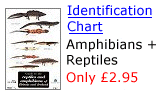Scientific name: Alytes obstetricans
Size: Approx 3 - 5cm
Distribution: Small populations can be found in Hampshire, Bedfordshire, Hertfordshire, S.W. London, Devon, Yorkshire and Northamptonshire
Months seen: March to October. Hibernates in winter, often in disused animal holes.
Habitat: Normally found on dry sandy soils. Frequently seen in gardens.
Food: Beetles, flies and other small invertebrates
Special features: Midwife toads are native in Europe from Germany southwards. They're similar in appearance to Common toads, except the snout is a bit more pointed and the pupil of the eye has a horizontal slit (the common toad has a vertical split - see the top of this page).
The skin colour can vary from grey to green to brown. The females sometimes have red spots on their flanks.
Between May and August Midwife toads make a high-pitched "beep beep" sound. It's surprisingly loud for such a small amphibian. The noise is entertaining at first, but after a while becomes irritating. People who live near to them often complain of sleepness nights.
During the spring and summer the female lays her eggs onto the male (see photo above). He fertilizes them and then wraps them around his back legs to protect them from predators (hence the 'midwife' name). When they are ready to hatch, the male releases into shallow water. The tadpoles can grow to 9cm.
Midwife toads have no legal protection as they are an introduced species.
 Midwife Toads
Midwife Toads






